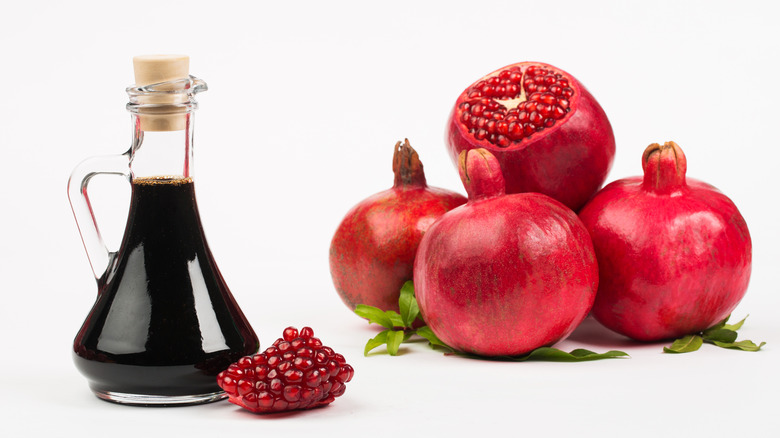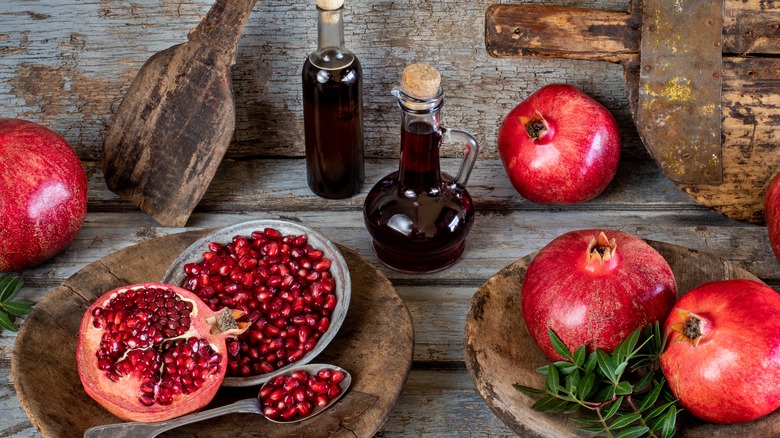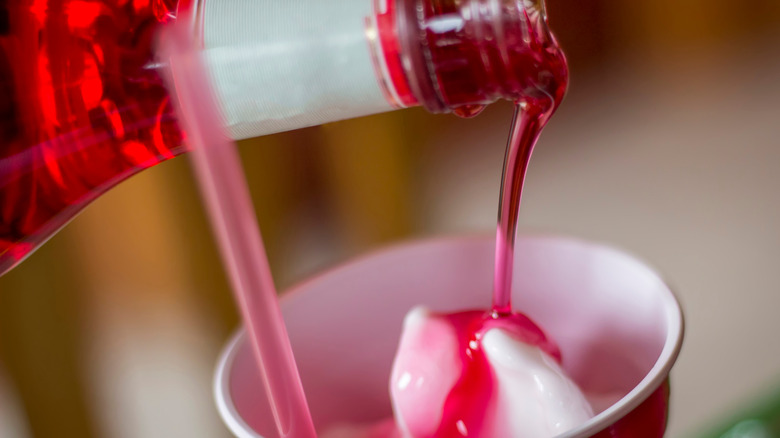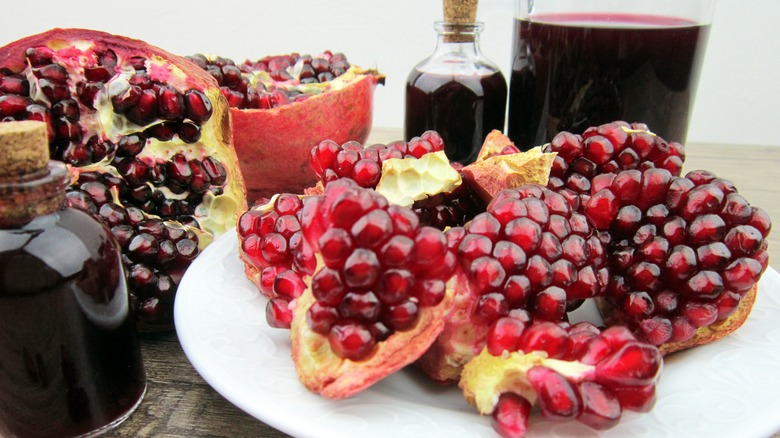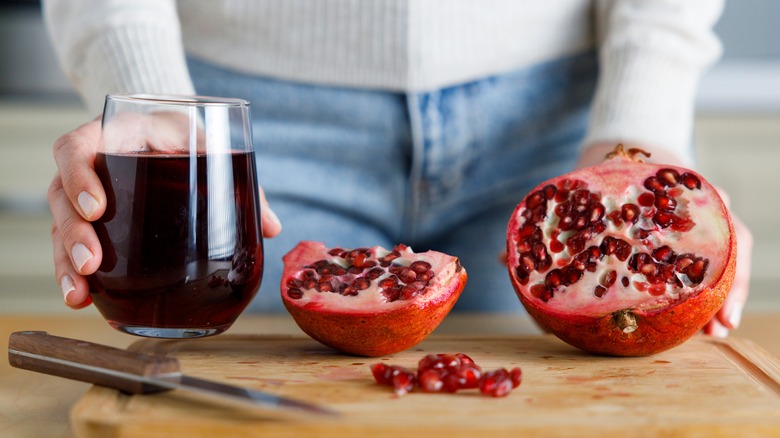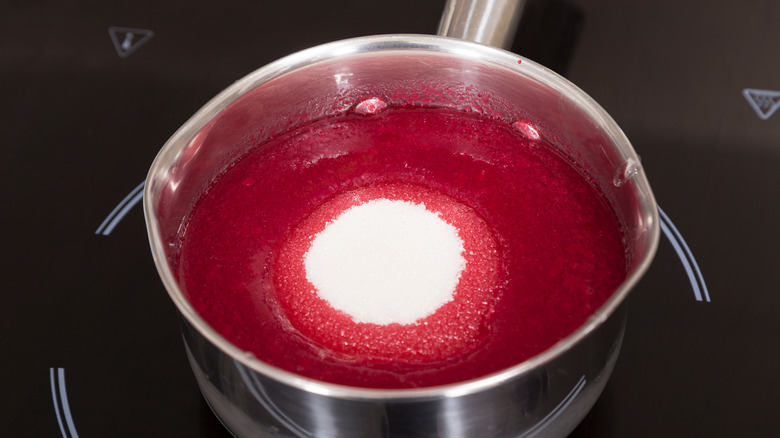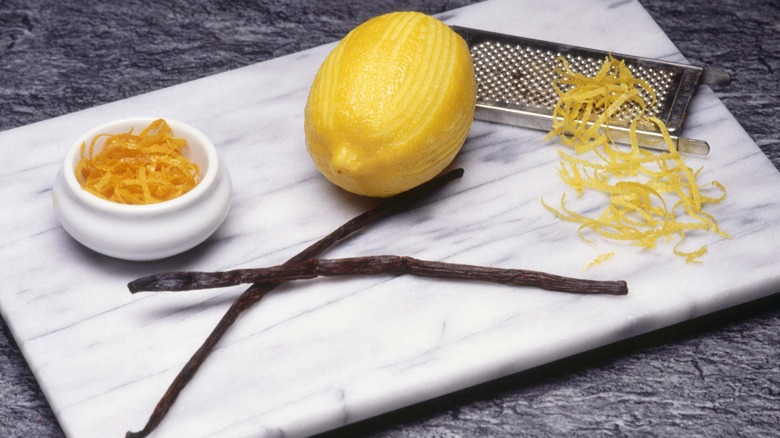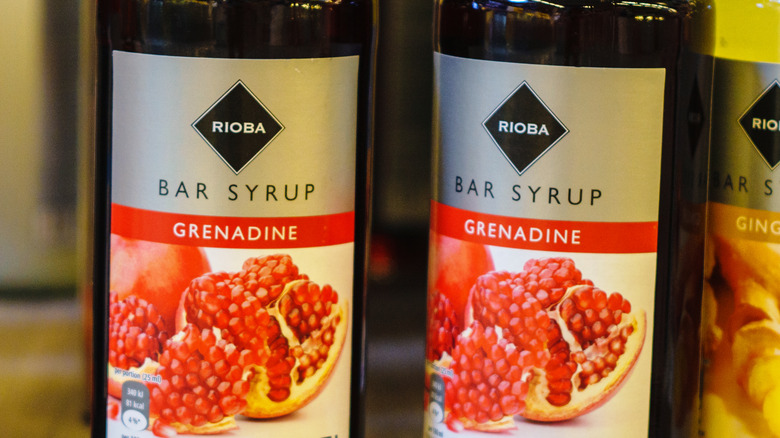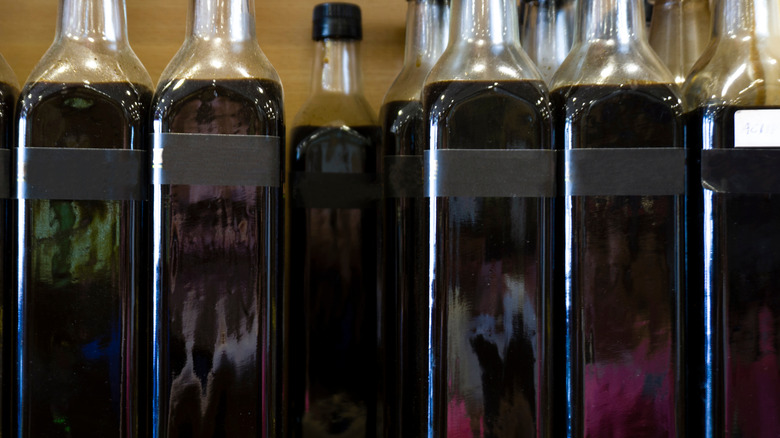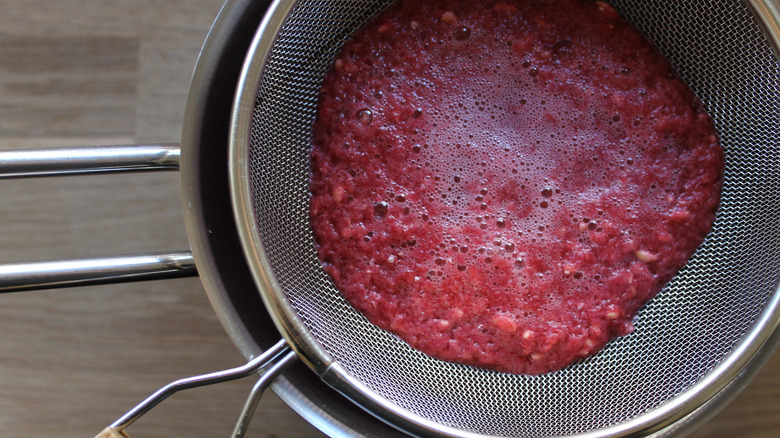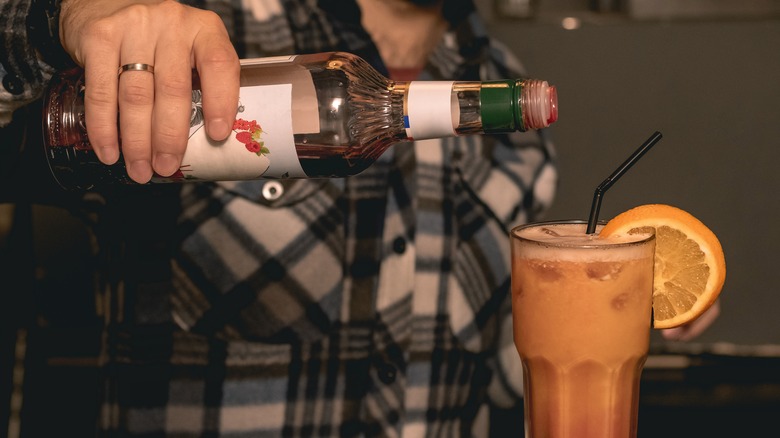Should You Buy Or Make Your Own Grenadine?
You've undoubtedly seen grenadine behind many bars. After all, it's a gleaming bottle full of bright red liquid, glowing like a fiery ruby. Plenty of people are introduced to this drink ingredient staple at a young age — it's the syrup that sweetens and ruddies Shirley Temples and Roy Rogers. It's also famous (or infamous, depending on who you ask) as an element in many classic and modern cocktails, as Vinepair points out, and as such, it's an essential item to have on hand for people who like crafting cocktails and mocktails at home.
But what exactly is grenadine, and is it better to make it or buy it? There may not be cut-and-dry, easy answers to those questions, but here you will find some guides and basic information that can help you decide whether you should take on grenadine-making as a DIY project, or opt for the store-bought stuff. There are advantages and disadvantages to either option, and plenty of pointers to keep in mind for both. Regardless if you choose to make it or buy it, having a steady supply of grenadine will definitely upgrade your home bartending game.
Grenadine has a murky history
Grenadine began to rear its head in cocktail recipes around the end of the 19th century, as Camper English discusses on his Alcademics blog. By 1914, it had made its way into a slew of drinks, and over the next several decades settled in as an entrenched cocktail ingredient in classic bartending bibles like the Savoy Cocktail Book from 1930. Drinks with grenadine from that era like the Jack Rose are still popular today, but is the grenadine used by contemporary bartenders the same as the stuff that was poured nearly a century ago?
The syrupy mixture is named for its main ingredient, pomegranate — the French word for the fruit is grenade (per Vinepair). Original grenadine, made from real pomegranates, was long popular in France and the rest of Europe, by way of the Middle East (per Alcademics). It was produced in the U.S., too, but sadly, around the time grenadine cocktails started to catch on, a court ruling decided that grenadine did not have to contain any pomegranate whatsoever. Eventually that was doubled down on, with a declaration that the syrup doesn't need to include any fruit (per Alcademics).
These decisions led to a glut of sketchy so-called grenadine products flooding the American market, made with citric acid and coloring agents to somewhat resemble the original pomegranate syrup. Therefore, unfortunately, it's impossible to know which type of grenadine — real or artificial — early mixologists were using when they created these classic cocktails.
What is real grenadine?
In its simplest form, grenadine consists of pomegranate juice and sugar, cooked down or otherwise thickened to a syrupy consistency, as described on Master Class. It's not a liqueur, which makes it a great ingredient to have around for both cocktails and non-alcoholic beverages, giving it plenty of versatility in your home bar. Grenadine adds color, aroma, and flavor to drinks, and as a bonus you get the health benefits of pomegranate, too. The fruit has useful anti-inflammatory and antioxidant properties, per the National Library of Medicine/
Most grenadine recipes call for the addition of other flavorful elements, most commonly orange blossom water and pomegranate molasses (per Alcademics). But this is not always the case — well-known artisanal producer Small Hand Foods keeps their grenadine simple to accentuate the pure pomegranate flavor. While grenadine may not have a written-in-stone definition, one thing it should not be confused with is pomegranate molasses, which is made from reduced pomegranate juice, typically with little or no added sugar. It's much tangier and tarter than grenadine, so the two substances are not exactly interchangeable.
Most commercial grenadine is nothing like the real thing
Thanks to the modern craft cocktail movement, there are plenty of well-made grenadines with natural ingredients on the market. However, more often than not, you're still more likely to come across the glowing bright red, industrially-produced concoctions on store shelves. These types of grenadine syrups, like Rose's, are common and fairly cheap, so you may wonder if it's worth it to seek out their artisanal counterparts. What exactly is the difference?
Whether hand-crafted or factory-produced, each grenadine brand has its own unique recipe, as Mr. Boston breaks down. The ubiquitous Rose's may be the cheapest and easiest to find, but you can see why when you check the ingredient list. In it you'll find that high fructose corn syrup leads the way, with no actual fruit components to speak of aside from one mention of natural and artificial flavors. The syrup's neon red color comes from Red #40 and Blue #1 dyes, making it about as far away from true pomegranate syrup as you can get.
Other major large-production brands, like Monin, may be a slight improvement, as corn syrup is swapped out for cane sugar. However, it's still a far cry from those produced from real fruit. If your main concern is price, these grenadines may be what you're after, but other than that you'll want to consider other options.
Making your own grenadine: key elements
When you decide to make your own grenadine, you're faced with many choices. First and foremost, you'll want to decide on your pomegranate juice, including whether you should buy whole fruits or bottled juice? Either of these options is viable and can produce great results — your decision may depend on how much work you want to put in, as Jeffrey Morgenthaler discusses. There's nothing wrong with using bottled juice, as long as you check the label to make sure you're buying 100% pomegranate juice, and not some sugary, preservative-filled mixture.
The second necessary ingredient is sugar. Nothing too complicated here. While Master Class specifically calls for demerara sugar, which is less processed than many other types, it's fine to use whatever sugar you have on hand. Once you have these key elements figured out, you can experiment with other optional flavoring ingredients to suit your own personal taste, or keep it simple and stick with just these two essentials.
Making your own grenadine: how to juice pomegranates
Starting with whole pomegranates rather than store-bought juice requires a little bit more effort when making homemade grenadine. Breaking down the fruits to get juice from each seed inside can seem like a daunting prospect, but as Jeffrey Morgenthaler points out, if you have a citrus juicer, the process is quick and easy — the red orbs can be sliced in half and pressed just like many other fruits.
If you lack a juicer, or just want to be more hands-on with the process, you can utilize a technique like this one from Soil Born Farms. It involves separating the fruit into sections by gently slicing into the rind without disturbing the juice-filled seeds, then loosening said seeds in a bowl of water. Keeping the seeds in water helps to avoid splattering and staining. Once the seeds are released from the rest of the fruit, they can then be squeezed for their juice in a bag, bowl, or any other vessel. The solids can then be strained away, leaving behind only pure, super-fresh pomegranate juice.
Making your own grenadine: to heat or not to heat
Once you've gathered your pomegranate juice and sugar, the next step is to process the two ingredients and create a basic grenadine. Essentially, you need the sugar to dissolve into the liquid so that it thickens it into a syrupy consistency. There are two types of methods you can utilize for this to occur, as Cocktail Chronicles discusses — one uses heat, and one uses agitation.
Heating the sugar and juice together not only results in both elements combining to form a syrup, but since it's cooked, the liquid is also slightly reduced, creating a thicker, richer style of grenadine. If you prefer a lighter style that accentuates fresh pomegranate flavor, you can avoid using heat and simply shake the juice and sugar in a closed container, such as a lidded jar, until the two ingredients are fully integrated and a syrup is formed.
If you opt for the heating method, Jeffrey Morgenthaler recommends keeping it low and brief — this will result in a syrup with properly liquified sugar that hasn't lost the fresh essence of raw pomegranate flavor. You can even use a microwave to make the heat method even more convenient.
Making your own grenadine: optional ingredients
Once you've perfected your base grenadine using pomegranate juice and sugar, you can experiment with additional ingredients to boost the texture, aroma, and flavor of your syrup. Two commonly found elements are pomegranate molasses and orange blossom water, per Vinepair. Pomegranate molasses, as described previously, is thicker, tarter, and less sweet than grenadine — this substance can add texture and richness as well as acidity to your grenadine, and can be store-bought or homemade. Orange blossom water, like this one from Nielsen-Massey, is used to add a floral fragrance to baked goods and savory dishes, as well as cocktails like the Ramos Gin Fizz. It'll help bump up the aromatic intensity of your grenadine.
Mixologists and cocktail enthusiasts all seem to have their preferred additions and methods when it comes to crafting grenadine, as discussed in Punch, from spices to fresh herbs to oils, and even sea salt. Before settling on their simple formula, Small Hand Foods experimented with the additions of vanilla and hibiscus. There really is no limit to what you can play around with when it comes to grenadine, whether you want to keep things pure and straightforward, or become a grenadine trailblazer creating avant-garde flavor combinations.
Buying grenadine: what to look for
There are plenty of reasons to forego making your own grenadine and opt for store-bought instead. Maybe you're not the crafty type, or you're short on time. No need to fret — it's never been easier to procure high-quality grenadine that can rival, or even outclass its homemade countepart. There are legions of brands out there, some of which are discussed on Mr. Boston and Drinkhacker, and each brings its own unique characteristics to this versatile syrup.
If your main grenadine concern is keeping it real — as in, real pomegranate and few additives — you may have to cede some ground when it comes to color. As Small Hand Foods discusses, real pomegranate juice has a darker, purpler hue, which is nothing like the bright cough syrup-looking red that so many commercial grenadines show, thanks to artificial coloring. Other brands that eschew using lab-created food dyes are Liber & Co. and Jack Rudy. The difference between grenadines that use artificial coloring and those that don't is obvious when you see them side-by-side.
If you happen to be nostalgic for the candy-red appearance you may remember from your childhood Shirley Temples, there are other options available such as Barsmith that are not quite pure, but thankfully lack the corn syrup base of some of the bigger mass-produced brands. Once you figure out which style you're looking for, a quick look at the ingredient list should tell you all you need to know about its quality.
How to store homemade or store-bought grenadine
Many recipes that use grenadine call for only small amounts of the syrup, which means a large batch or bottle might find itself sitting around for a long time. So what's the best way to store grenadine so that it stays as fresh as possible for as long as possible? That depends on a few factors, according to Choosing Nutrition.
Store-bought grenadine will typically last longer than homemade grenadine, and may last years, especially if the bottle hasn't been opened. Grenadines with artificial flavors and colors that don't contain perishable fruit juice will last longer than those made with fresh ingredients. For all store-bought grenadines, it's best to pay attention to the best-by date as flavor can fade and quality can go downhill once it's passed. Once you've opened the bottle, it'll last much longer if kept refrigerated, at least several months more than if it's kept at room temperature.
Homemade grenadine generally has a shorter lifespan, although you can lengthen it by adding alcohol such as vodka as a preservative (one ounce per batch, according to Jeffrey Morgenthaler's instructions). Keeping your homemade grenadine constantly refrigerated and sealed will also help provide the longest possible lifespan. As with all food and drink products, if you notice it looks or smells off, it's best to toss it and make a fresh batch.
Advantages of homemade grenadine
Making your own grenadine may not be the easiest option, but it will give you the most control over the final product because of the fact that you can tweak each step and ingredient to match your preferences and needs, per Stir & Strain. You can adjust the juice to sugar ratio to make it as sweet as you like, or you can add additional ingredients to create your own unique flavor profile. Additionally, you can make as much or as little as you need, like crafting a large batch for parties, or a tiny batch if you just want a little bit with a super-fresh taste.
Since high-quality 100% pomegranate juice is readily available in many supermarkets, making grenadine is easier than it's ever been. If you opt to break down and use whole pomegranates, you'll know that the juice you're using is as fresh as possible. For those who enjoy getting their hands dirty with DIY cooking projects, making your own grenadine can be fun, and once you develop your ideal recipe, you can easily recreate it, thus always ensuring you have your favorite grenadine available for your cocktails and mocktails.
Advantages of store-bought grenadine
There are lots of advantages to buying grenadine instead of making it, but the main and most obvious one is convenience. As Stir & Strain points out, there isn't too much of a difference when comparing store-bought to homemade — of course, this will vary based on which store brand is used, and what homemade recipe is followed. But generally, a good quality store-bought grenadine is comparable to homemade and saves both time and effort.
If you're not particularly handy in the kitchen, or if you just hate doing dishes, buying grenadine instead of making it is a no-brainer — a kitchen accident involving pomegranate is no joke, as the inky juice can leave stains no matter how careful you are. Another advantage of store-bought over homemade grenadine is its longer shelf life, not to mention the consistent flavor and quality you'll get from buying a professionally crafted product. With the range and quality of store-bought syrups on the market today, no one is any less of a mixologist for using commercial rather than homemade grenadine.
Recipes to make with grenadine
Now that you've got your store-bought bottle or homemade batch of grenadine — what should you do with it? Grenadine's fruity, sweet-tart profile is a great addition to any drink that needs a little flavor boost. As Proof Syrup lays out, it's incredibly versatile, and can complement any spirit family, from neutral vodka to smoky mezcal to herbal, aromatic gin. Because of this, don't be afraid to experiment as there's hardly a liquor that grenadine won't play well with. As stated before, it's also a great option for mocktails and a splash of grenadine can enhance the flavor of any soda or juice, helping add excitement to regular everyday drinks.
Even if you think you've outgrown them, a Roy Rogers or a Shirley Temple can be delicious at any age when made with a high quality store-bought or homemade grenadine (and a little bit of booze can turn that Shirley into its grown-up version, the Dirty Shirley). Additionally, a small addition of the syrup is a great way to add a little extra oomph to your morning mimosa. And there are tons of classic grenadine cocktails that any bartending enthusiast should try, like the rum-based El Presidente and the apple brandy sour known as the Jack Rose. No matter whether you decide to embark on a DIY grenadine journey, or find your perfect store-bought brand, grenadine should be a part of everyone's home bar.
